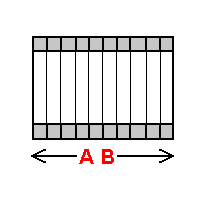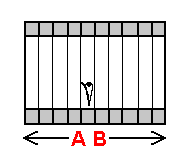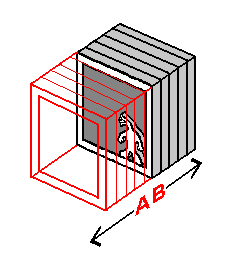

Our first step toward understanding the 3-plane array will involve examining representations of the 1-plane array and 2-plane array, and laying down specific conclusions based upon the observations - conclusions without which we could not construct a 3-plane array.
 |
 |
|
1. Each room / plane possesses 2 distinct "sides".
2. Each room / plane possesses a distinct "thickness" that allows the rooms to accumulate and extend outward.
3. This 'outward extension' occurs in 2 distinct directions, both of which lie perpendicular to the rooms / planes themselves. These directions will be referred to as 'direction A' and 'direction B'.
 |
 |
On the right, a new element is added to each 'array of rooms': a subject. A Linelander is added to a central plane of the 1-room array, and a Flatlander is added to a central plane of the 2-room array. It is the placement of a subject onto a central plane of each array that allows for a whole new approach toward the method of study. As the first step towards harnessing this new approach, we will familiarize ourselves with each subject's situation and with how he experiences his environment.
The first thing to be aware of is that the subject within each array can experience only one plane of the array at any given time. What this means is that of all the planes / rooms we observe these arrays to consist of, each subject is aware only of the room that he inhabits. To the subject, it's as if the planes / rooms surrounding his own plane, didn't even exist. Furthermore, the subject's confinement to the dimensions of his plane prevents him from detecting the 2 "sides" to his plane that are so clear to us. His inability to detect these "sides" lies in the fact that the directions in which these "sides" lie, are directions that extend perpendicular to the very dimension to which the plane / room belongs.
Given each subject, and the array of rooms / planes in which he lies, assume that we have the task of 'explaining' to each subject precisely "where", in relation to his own plane, the rest of the planes of this array lie. What would we tell them? After thinking about it for a while, I feel that the best answer would be: "the rooms surrounding your own room occupy the same space as it does". This is accurate in that it's an explanation that the Linelander / Flatlander can understand: as of their own dimension, there's simply no way to "express" the separateness of the plane they inhabit, from the planes surrounding it. There is, however, a 'way around' this - a way provided by an invaluable 'mental tool' known as a stack-diagram.
| to previous section |
to table of contents |
to next section |
||
| Comments, questions, feedback: [email protected] |